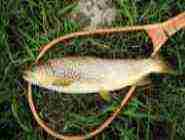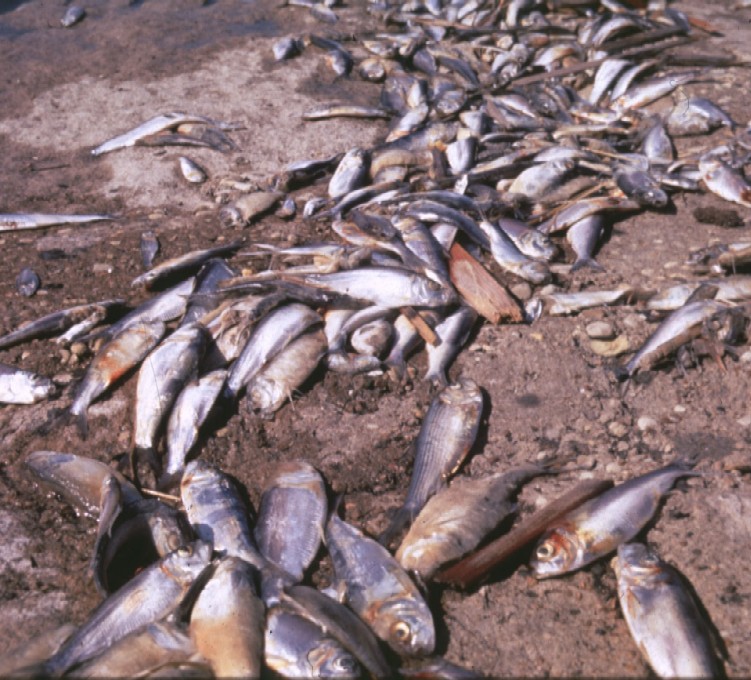Coldwater
Ponds
| Warmwater Ponds| Determining
Balance
Fish Kills| Fish
Parasites| Fish
Suppliers
Different types of ponds support different types of fish, largely depending on the water temperature. Coldwater ponds have a summer maximum temperature of less than 74° F, while warmwater ponds reach temperatures above 74° F during the summer months. Due to cooler temperatures, coldwater ponds which can sustain various trout species. Warmwater ponds are suitable for bass, sunfish and catfish. Below are suggested management practices for both coldwater and warmwater ponds.
Various kinds of trout have been tested in New York farm ponds, including brook, brown and rainbow trout. Trout survival through the summer months is often the greatest challenge, due to their inability to tolerate warmer temperatures. Fish should be stocked during cool weather. Trout stocked as 2-inch spring fingerlings (2-3 months old) have a lower survival rate than fish stocked as 5½-inch fall fingerlings (7-8 months old). Larger fish have higher survival rates, but these fish are also more expensive to purchase. Trout reach catchable size in spring following stocking.
Trout should be stocked in ponds without other fish, where they will feed upon aquatic insects and other small pond crustaceans. In some cases, large trout can be stocked in ponds with minnows as these forage fish will provide an additional boost to trout growth rates. It is unusual to find trout surviving into their third year after being stocked into a farm pond, so it is reasonable to harvest these fish within a year or two after stocking. Stocking density is highly dependent on pond productivity- ponds with more nutrient inputs can support more fish.
General recommended stocking densities:
600 trout fingerlings per acre of pond surface area.
While brook and rainbow trout provide
for good pond fishing, brown trout are less popular because they are difficult
to catch and may feed on fingerlings.
Back to top
Adult largemouth bass are the most
popular sport fish stocked in warmwater ponds. As predators upon smaller
fish, they must be stocked in a pond that contains forage fish. Largemouth
bass are popular for angling, because they put up a real battle when caught
by hook and line.
Sunfish as Prey Fish:
Farm ponds in the southern U.S. are frequently stocked with combinations
of largemouth bass and bluegill sunfish, since the bluegill reproduce
easily and small bluegill provide food for the larger bass. Hybrid sunfish
are now sometimes used in place of bluegill. These hybrid fish are a cross
between two different sunfish species, usually a bluegill and a green
sunfish. Hybrid sunfish spawn less prolifically than bluegill because
most of these fish are males.
Minnows as Prey Fish:
Another alternative is to stock golden shiners or fathead minnows as forage
for largemouth bass. In such ponds the shiners or minnows will likely
disappear after several years due to predation by the bass and lack of
reproduction. Though this can be an expensive alternative, good bass growth
rates can be sustained by continuing to stock abundant forage fish in
ponds where your goal is to produce largemouth bass for angling.
As in coldwater ponds, stocking density is based on pond productivity- ponds with more nutrient inputs can support more fish.
General Recommended Stocking Densities:
500 sunfish fingerlings per acre of pond surface area; 100 bass fingerlings/acre.
Channel catfish can also be stocked as a compliment to a largemouth bass-sunfish community. Catfish do very well in warm waters 70-85 ° F; however, because they generally don't reproduce well in small ponds, they need to be restocked every 2-3 years. If bass already inhabit the pond, stock catfish at least 8-10 inches in length to avoid immediate predation.
General Recommended Stocking Densities:
750 sunfish fingerlings per acre, 70 catfish fingerlings/acre, and 100 bass fingerlings/acre.
Adjust these initial recommendations
up or down based on success and the productivity of your pond.
Back to top
When is a fish population in balance? How can I determine if a balanced condition exists in my pond? These are two questions often asked by pond owners. Actually, a truly balanced condition never exists in a pond, or the balanced condition might be one that does not produce satisfactory fish for purposes of recreation. Fish populations continually change and never reach the state of equilibrium, or general stability, often referred to as balance. Fisheries biologists sometimes use the term to describe satisfactory relationships between the predator and prey populations in a pond, in which case they are usually identifying three factors as being present
(1) Fish of harvestable size;
(2) Annual reproduction;
(3) A combination of fishes, including at least one predator species.
However, achieving all three factors
is not easy to attain in many farm ponds. Figuring out what’s possible
in your pond will require a flair for experimentation, good observation,
and some patience.
Back to top
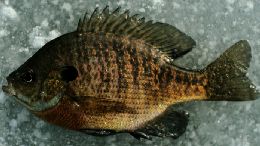 Bluegill |
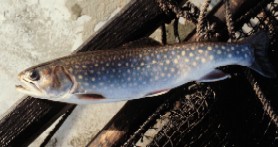 Brook Trout |
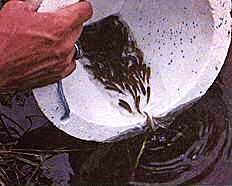 Stocking Fish |
|
|
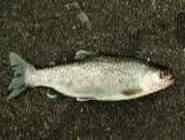 Rainbow Trout |
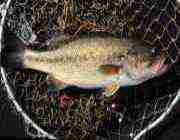 Largemouth Bass |
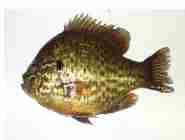 Pumpkinseed |
 Golden Shiner |
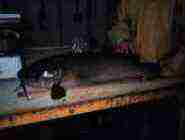 Channel Catfish |
| |
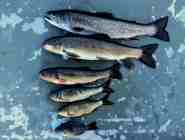 |
